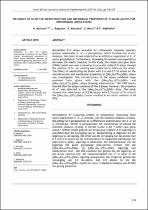 ResearchSpace
ResearchSpace
Influence of SN on the microstructure and mechanical properties of TI-MO-NB alloys for orthopaedic applications
JavaScript is disabled for your browser. Some features of this site may not work without it.
- ResearchSpace
- →
- Research Publications/Outputs
- →
- Journal Articles
- →
- View Item
| dc.contributor.author |
Muchavi, Noluntu S

|
|
| dc.contributor.author |
Raganya, Mampai L

|
|
| dc.contributor.author |
Machaka, R

|
|
| dc.contributor.author |
Motsi, Glenda T

|
|
| dc.contributor.author |
Makhatha, E

|
|
| dc.date.accessioned | 2023-03-17T08:06:15Z | |
| dc.date.available | 2023-03-17T08:06:15Z | |
| dc.date.issued | 2022-11 | |
| dc.identifier.citation | Muchavi, N.S., Raganya, M.L., Machaka, R., Motsi, G.T. & Makhatha, E. 2022. Influence of SN on the microstructure and mechanical properties of TI-MO-NB alloys for orthopaedic applications. <i>South African Journal of Industrial Engineering, 33(3).</i> http://hdl.handle.net/10204/12674 | en_ZA |
| dc.identifier.issn | 2224-7890 | |
| dc.identifier.uri | https://doi.org/10.7166/33-3-2806 | |
| dc.identifier.uri | http://hdl.handle.net/10204/12674 | |
| dc.description.abstract | Metastable ß-Ti alloys intended for orthopaedic implants typically possess undesirable a', a", precipitates, which increase the elastic modulus. Non-toxic Sn was reported as an effective suppressor of a', a" and precipitates. Furthermore, increasing Sn content was reported to decrease the elastic modulus. In this study, the cluster plus glue atom (CPGA) model was used to develop structurally stable ß-Ti alloys through the addition of Sn. Arc melting was conducted to fabricate the alloys. The effect of substituting Mo atoms with 0.4 and 0.5 Sn atoms on the microstructure and mechanical properties of [(Mo,Sn)(Ti)14](Nb)1 alloys was investigated. The microstructure of the alloys exhibited large equiaxed beta grains with the [(Mo0.6Sn0.4)(Ti)14](Nb)1 and [(Mo0.5Sn0.5)(Ti)14](Nb)1 alloys showing substructures. The XRD results showed that the alloys consisted of the ß phase; however, the presence of a” was observed in the [(Mo0.6Sn0.4)(Ti)14](Nb)1 alloy. The study showed that substitution of 0.5 Mo atoms with 0.5 atoms of Sn to form the [(Mo0.5Sn0.5)(Ti)14](Nb)1 cluster resulted in an elastic modulus of 49 GPa. | en_US |
| dc.format | Fulltext | en_US |
| dc.language.iso | en | en_US |
| dc.relation.uri | http://sajie.journals.ac.za/pub/article/view/2806 | en_US |
| dc.source | South African Journal of Industrial Engineering, 33(3) | en_US |
| dc.subject | XRD analysis | en_US |
| dc.subject | Mechanical properties | en_US |
| dc.subject | Orthopaedic applications | en_US |
| dc.subject | TI-MO-NB alloys | en_US |
| dc.title | Influence of SN on the microstructure and mechanical properties of TI-MO-NB alloys for orthopaedic applications | en_US |
| dc.type | Article | en_US |
| dc.description.pages | 318-325 | en_US |
| dc.description.note | Authors retain copyright and grant the Journal right of first publication with the work simultaneously licensed under a Creative Commons Attribution License that allows others to share the work with an acknowledgement of the work's authorship and initial publication in this Journal. | en_US |
| dc.description.cluster | Manufacturing | en_US |
| dc.description.impactarea | Advanced Materials Engineering | en_US |
| dc.description.impactarea | Powder Metallurgy Technologies | en_US |
| dc.identifier.apacitation | Muchavi, N. S., Raganya, M. L., Machaka, R., Motsi, G. T., & Makhatha, E. (2022). Influence of SN on the microstructure and mechanical properties of TI-MO-NB alloys for orthopaedic applications. <i>South African Journal of Industrial Engineering, 33(3)</i>, http://hdl.handle.net/10204/12674 | en_ZA |
| dc.identifier.chicagocitation | Muchavi, Noluntu S, Mampai L Raganya, R Machaka, Glenda T Motsi, and E Makhatha "Influence of SN on the microstructure and mechanical properties of TI-MO-NB alloys for orthopaedic applications." <i>South African Journal of Industrial Engineering, 33(3)</i> (2022) http://hdl.handle.net/10204/12674 | en_ZA |
| dc.identifier.vancouvercitation | Muchavi NS, Raganya ML, Machaka R, Motsi GT, Makhatha E. Influence of SN on the microstructure and mechanical properties of TI-MO-NB alloys for orthopaedic applications. South African Journal of Industrial Engineering, 33(3). 2022; http://hdl.handle.net/10204/12674. | en_ZA |
| dc.identifier.ris | TY - Article AU - Muchavi, Noluntu S AU - Raganya, Mampai L AU - Machaka, R AU - Motsi, Glenda T AU - Makhatha, E AB - Metastable ß-Ti alloys intended for orthopaedic implants typically possess undesirable a', a", precipitates, which increase the elastic modulus. Non-toxic Sn was reported as an effective suppressor of a', a" and precipitates. Furthermore, increasing Sn content was reported to decrease the elastic modulus. In this study, the cluster plus glue atom (CPGA) model was used to develop structurally stable ß-Ti alloys through the addition of Sn. Arc melting was conducted to fabricate the alloys. The effect of substituting Mo atoms with 0.4 and 0.5 Sn atoms on the microstructure and mechanical properties of [(Mo,Sn)(Ti)14](Nb)1 alloys was investigated. The microstructure of the alloys exhibited large equiaxed beta grains with the [(Mo0.6Sn0.4)(Ti)14](Nb)1 and [(Mo0.5Sn0.5)(Ti)14](Nb)1 alloys showing substructures. The XRD results showed that the alloys consisted of the ß phase; however, the presence of a” was observed in the [(Mo0.6Sn0.4)(Ti)14](Nb)1 alloy. The study showed that substitution of 0.5 Mo atoms with 0.5 atoms of Sn to form the [(Mo0.5Sn0.5)(Ti)14](Nb)1 cluster resulted in an elastic modulus of 49 GPa. DA - 2022-11 DB - ResearchSpace DP - CSIR J1 - South African Journal of Industrial Engineering, 33(3) KW - XRD analysis KW - Mechanical properties KW - Orthopaedic applications KW - TI-MO-NB alloys LK - https://researchspace.csir.co.za PY - 2022 SM - 2224-7890 T1 - Influence of SN on the microstructure and mechanical properties of TI-MO-NB alloys for orthopaedic applications TI - Influence of SN on the microstructure and mechanical properties of TI-MO-NB alloys for orthopaedic applications UR - http://hdl.handle.net/10204/12674 ER - | en_ZA |
| dc.identifier.worklist | 26574 | en_US |





